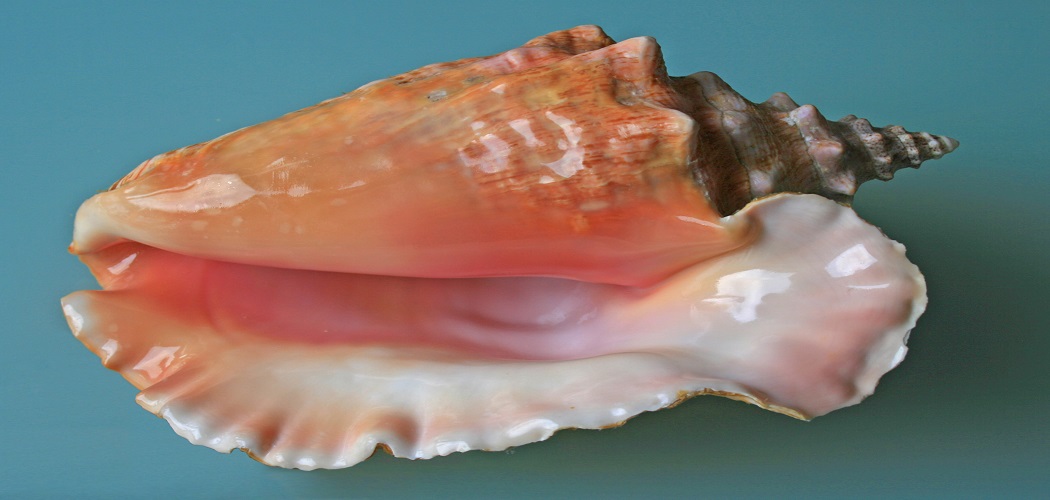How to Get Conch out of Shell without Breaking
Conchs are one of the most delicious and popular seafood. They are found in the warm seawater around the coastal area. Some people get the conch meat to eat, whereas other people only want the shell.

The conch shell can be used for various purposes but not for indulgence. So, if you are planning on getting the conch snail out of the body and not damaging the shell, we will tell you how to get the conch out of the shell without breaking. In this blogpost on how to get conch out of shell without breaking, we have discussed two methods that will help you to get the delicate flesh out of the shell without damaging its beautiful structure.
What is a Conch?
Conchs are type of marine mollusk that are found in tropical and sub-tropical waters. They have a beautiful spiral shell with a pointed tip, which is used as protection for their soft body. The conch meat is consumed by humans all around the world, making it one of the most sought after seafood. The shell of the conch is also used for decorative purposes and has been used in traditional crafts such as jewelry, ornaments, and musical instruments.
Why is Getting Conch out of Shell a Challenge?
Getting a conch out of its shell without causing any damage is not an easy task. The conch has a tightly attached muscle that keeps the snail secured inside the shell, making it difficult to remove without breaking the delicate structure. Moreover, the tip of the shell is very fragile and can easily break off if handled with force.
You may think that breaking the shell is an easier option, but it can be quite tricky. If you break the shell in the wrong place, you might end up damaging the flesh inside or even worse, injuring yourself.
Safety Concern
Before we can start with the work, you need to know some necessary safety measures. The shell of the conch can hurt you if you are not careful. Usually, the body is made in a way that will protect the snail. It has some sharp edges that could cut the intruder.

That is why you should not touch the shell with bare hands. You must wear thick plastic gloves when working with the shell and some Google over the eyes to protect them from unwanted events. In addition, you need to keep the safety of the surrounding people in mind while working with the shell.
You must follow all the safety precautions to avoid any accidents or injuries.
Needed Materials:
Conch Snails:
You need to collect some conch snails from the beach or buy them at a seafood market. Make sure they are alive before buying.
Salt:
Salt is a crucial ingredient in this process as it helps to loosen the snail from its shell. You will need varying amounts of salt for soaking the conchs in different tubs of water.
Plastic Gloves:
Wear plastic gloves to protect your hands while handling the shells. This will also prevent any accidents or injuries that may occur due to sharp edges.
Goggles:
Wearing goggles is important to protect your eyes from any potential hazards while working with the shells.
Drill (Optional):
If you are having trouble taking out the snail, you can use a drill to create a small hole in the shell. This will help release the suction and make it easier to remove the snail without causing any damage.
10 Step-by-step Guidelines on How to Get Conch Out of Shell Without Breaking:
Step 1: Prepare the Conch
Soak the conch in tubs of salt water for an hour according to the different salt measurements. You can also add some lemon juice to the water for a better cleaning. You can also soak the shells separately to remove any residue or dirt. The saltwater will help loosen the snail from the shell. It is important to use the right salt measurements, as excessive salt can cause discoloration of the shells.

Always remember to handle the shells with care, as they are very delicate and can easily break. It is important to keep the snails alive until you are ready to remove them from the shell.
Step 2: Wear Safety Gear
Put on your plastic gloves and goggles before handling the shells. This will protect you from any potential injuries while working with sharp edges. But make sure the gloves are not too thick that you cannot feel the snail inside the shell. It is important to have a good grip on the shell while removing the snail. You can also use a towel for better grip if needed. But be extra careful not to put too much pressure on the shell. It is delicate and can break easily.
You can also use a drill to create a small hole in the shell to release suction. However, it is important to be cautious while drilling as it can damage the snail or the shell.
Step 3: Find the Main Entrance
The main entrance of the conch shell is where the snail’s pointed tip is located. This is where you will need to grip and pull out the snail. It might be a little tricky to find the entrance at first, but with practice, you will get better. The entrance usually has a small hole or indentation that indicates where the snail is located. You can also tap the shell lightly to locate the snail. You will hear a hollow sound where the snail is positioned.

But be careful, as this spot is the most fragile part of the shell and can easily break. It is important to hold the shell in a way that distributes the weight evenly and avoids any unnecessary pressure on one spot.
Step 4: Use Zigzag Motion
To loosen the suction of the snail inside the shell, you will need to pull with a zigzag motion. This means pulling in one direction and then changing to another direction immediately. This will help weaken the muscle holding the snail and make it easier to remove. It is important to be gentle while pulling, as too much force can cause the snail to break. You can also use a towel or cloth to get a better grip on the shell.
You can also use the drill at this step to create a small hole near the entrance. This will help release suction and make it easier to remove the snail. The hole should be small and precise, as a large one can damage the snail or the shell.
Step 5: Drill a Hole (Optional)
If you are having difficulty removing the snail, you can use a drill to create a small hole in the shell. This will help release the suction and make it easier to remove the snail without causing any damage. Make sure not to drill too deep or use excessive force as it can damage the shell. Also, be cautious while handling the drill. A small drill bit is recommended for better control. You can also use a hammer and nail to create a small hole.
It is important to note that drilling a hole can damage the shell and make it unsuitable for decorative purposes. You can only use this step if you are planning to cook the snails.
Step 6: Pull Out the Snail
Once you have loosened the snail from its shell, you can now pull it out. Make sure to hold onto the snail firmly while pulling, as it can slip out of your hand easily. If needed, you can use a fork or small spoon to gently remove the snail from the shell. Be careful not to damage the meat inside. The snail should come out easily if you have followed the previous steps correctly. It is important to be gentle while handling the snail as it can easily break.

However, if you are having difficulty removing the snail, you can soak it in salt water for a few more minutes to loosen it further. It is important to keep an eye on the snail as leaving it too long in water can cause discoloration or damage to the meat.
Step 7: Remove Protective Layer
Before cooking, you will need to remove the upper protective layer of the snail. This thin film-like layer covers the meat and can be easily removed with your fingers or a knife. Make sure to remove it gently without damaging the meat inside. The layer can also be removed before soaking the conch in salt water, but it is easier to remove after.
You can also choose to cook the snail with the protective layer if you prefer. Some people believe that it adds flavor and texture to the dish. But make sure to clean it thoroughly before cooking.
Step 8: Clean and Rinse
After removing the protective layer, rinse the snail under cold running water. You can also use a small brush to clean any remaining dirt or residue from the meat. Make sure not to overclean the snail as it can affect the taste. Rinse until the water runs clear. Otherwise, the snail will have a fishy smell and taste.

The snail is now ready to be cooked and enjoyed in various dishes such as soups, stews, or even stuffed. You can also store the cleaned and prepared snails in an airtight container in the refrigerator for up to one week before cooking.
Step 9: Boil the Shells
To prepare the shells for serving, you need to boil them in hot water for about 10 minutes. This will help remove any remaining dirt or bacteria from the shell. Once boiled, rinse with cold water and set aside until ready to use. The shells can also be used to serve the cooked snail. It adds a unique touch to the dish and can be used as a decorative element.
You can also choose to clean the shells and use them for various crafts or home decorations. The conch shell is a versatile and beautiful material that can be used in many creative ways.
Step 10: Cook and Enjoy!
Now you are ready to cook your conch in whichever recipe you prefer. The traditional Bahamian way is to boil the meat with various herbs and spices for a delicious and nutritious meal. But there are endless possibilities when it comes to cooking conch, so get creative! And finally, enjoy your freshly caught and harvested conch meat! Remember to always handle and cook the snail properly to avoid any foodborne illnesses. Bon appétit! The possibilities for cooking with a conch are endless!

Following these guidelines on how to get conch out of shell without breaking will ensure that you can successfully remove the snail from its shell without damaging it. With practice and patience, you can become an expert at this process and enjoy the delicious taste of conch in various dishes. But always remember to follow safety precautions and handle the snail with care for a safe and enjoyable experience.
Tips:
- Soak the conch in salt water for an hour to loosen the snail from its shell.
- Wear safety gear such as gloves and goggles while handling sharp shells.
- Use a zigzag motion to weaken the muscle holding the snail inside the shell.
- If needed, you can use a small drill bit or hammer and nail to create a hole in the shell.
- Be gentle and careful while handling the snail to avoid breaking it.
- Remove the protective layer before cooking.
- Cook conch in various recipes for a delicious and nutritious meal.
- Always handle and cook the snail properly to avoid foodborne illnesses.
- Enjoy your freshly caught and harvested conch meat! The possibilities for cooking with a conch are endless.
- Have fun and get creative in the kitchen! Conch can be prepared in many different ways, so don’t be afraid to try new recipes and experiment with flavors.
Frequently Asked Questions
Can You Boil a Conch Out of Its Shell?
This is a difficult question because many factors affect whether or not it will boil out of its shell.
One factor is the size of the conch, which determines how much heat it can generate. Another factor is how thick the shell is, which also affects the amount of heat generated.
Lastly, the water’s temperature and salinity level will play a role in determining whether or not boiling can occur.
Are Conch Pearls Valuable?
Conch pearls are the most expensive type of pearl. A conch pearl is formed when a layer of nacre, or mother-of-pearl, is deposited on the inside surface of an empty shell by a siphon shrimp. It takes about ten years for this process to be completed, and then they are harvested from the sea.
Conch pearls are so valuable because they have the highest luster among all other types of pearls.
Do You Have to Declare Conch Shells?
To answer this question, we need to understand what a conch shell is.
A conch shell is a spiral-shelled marine gastropod mollusk belonging to the family Strombidae. The word “conch” probably derives from Old French coche, meaning “wheel.” Conchs are common along tropical and subtropical shores of the Atlantic Ocean, Indian Ocean, and Pacific Ocean. They have a coiled shape with the whorls spiraling in opposite directions; they also may be inflated by air or water when the animal is threatened or alarmed.
Conch shells can be used as an ingredient in various dishes such as soups and stews (e.g., bouillabaisse), salads (e.g., Caesar salad), and casseroles (e.g., coq au vin).
Is It Bad to Collect Shells?
There are a few ways to collect shells. You can collect them from the beach, buy them at a craft store, or go out and find them in your yard.

Collecting shells is generally safe because they don’t have sharp edges and aren’t toxic. However, if you plan on collecting large amounts of shells or any other sea creature, it’s best to use gloves so that you don’t accidentally get stung by the animal.
What Is Inside a Conch Shell?
A conch shell is a type of sea snail, specifically a member of the family Ovulidae.
It has a tough, ribbed exterior that can be polished to make it reflective and highly decorative.
The shell’s inside is divided into two chambers separated by an operculum or lid. One chamber contains digestive organs, while the other houses respiratory organs, muscles, and gonads.
Final Thoughts
Getting a conch snail out of the shell is an exciting yet delicate process. It requires patience and careful handling to avoid breaking the shell or harming yourself. By following the right steps and taking necessary safety measures, you can successfully remove the conch without any damage. Remember to prepare the conch beforehand and use gloves and goggles during the removal process. And don’t forget to properly cook and clean both the snail and the shell before use! We hope this guide has been helpful in teaching you how to get conch out of shell without breaking. Happy cooking!




